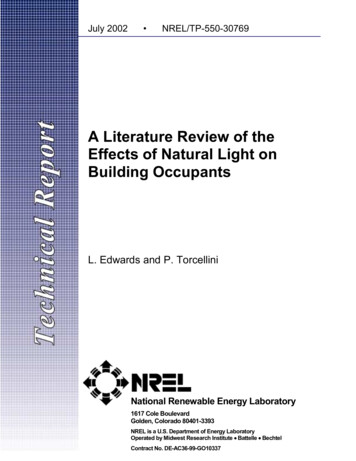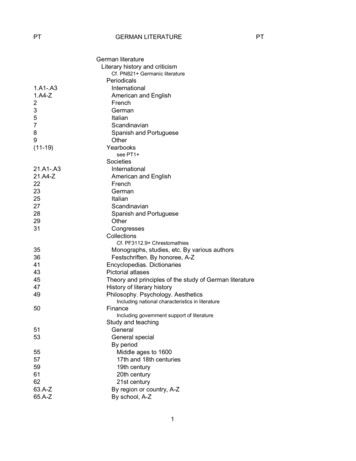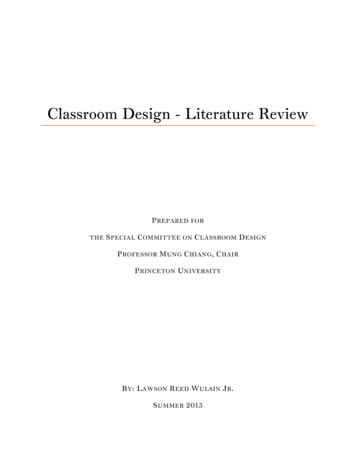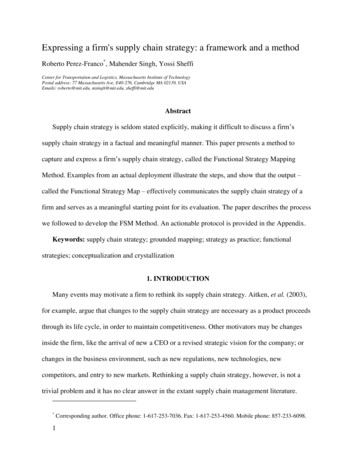
Transcription
July 2002 NREL/TP-550-30769A Literature Review of theEffects of Natural Light onBuilding OccupantsL. Edwards and P. TorcelliniNational Renewable Energy Laboratory1617 Cole BoulevardGolden, Colorado 80401-3393NREL is a U.S. Department of Energy LaboratoryOperated by Midwest Research Institute Battelle BechtelContract No. DE-AC36-99-GO10337
July 2002 NREL/TP-550-30769A Literature Review of theEffects of Natural Light onBuilding OccupantsL. Edwards and P. TorcelliniPrepared under Task No. BEC2.4002National Renewable Energy Laboratory1617 Cole BoulevardGolden, Colorado 80401-3393NREL is a U.S. Department of Energy LaboratoryOperated by Midwest Research Institute Battelle BechtelContract No. DE-AC36-99-GO10337
NOTICEThis report was prepared as an account of work sponsored by an agency of the United Statesgovernment. Neither the United States government nor any agency thereof, nor any of their employees,makes any warranty, express or implied, or assumes any legal liability or responsibility for the accuracy,completeness, or usefulness of any information, apparatus, product, or process disclosed, or representsthat its use would not infringe privately owned rights. Reference herein to any specific commercialproduct, process, or service by trade name, trademark, manufacturer, or otherwise does not necessarilyconstitute or imply its endorsement, recommendation, or favoring by the United States government or anyagency thereof. The views and opinions of authors expressed herein do not necessarily state or reflectthose of the United States government or any agency thereof.Available electronically at http://www.osti.gov/bridgeAvailable for a processing fee to U.S. Department of Energyand its contractors, in paper, from:U.S. Department of EnergyOffice of Scientific and Technical InformationP.O. Box 62Oak Ridge, TN 37831-0062phone: 865.576.8401fax: 865.576.5728email: reports@adonis.osti.govAvailable for sale to the public, in paper, from:U.S. Department of CommerceNational Technical Information Service5285 Port Royal RoadSpringfield, VA 22161phone: 800.553.6847fax: 703.605.6900email: orders@ntis.fedworld.govonline ordering: http://www.ntis.gov/ordering.htmPrinted on paper containing at least 50% wastepaper, including 20% postconsumer waste
Table of Contents1. Background . 22. Introduction. 23. Wavelengths of Light. 34. Affects of Light on the Body . 4How the Eye Works . 5Affects of Light on Internal Body Systems . 5Nervous and Endocrine System . 5Circadian Cycles . 6Medical Cures from Light. 7Rickets and Osteomalacia . 75. Daylighting in the Office . 9Health in the Office. 9Productivity in the Office. 10Absenteeism in the Office. 11Employee Turnover . 11Financial Savings . 12Employee Preferences and Perspectives . 14Improper Daylighting. 166. Daylighting in Schools. 17Health. 17Attendance . 19Achievement . 19Perspectives. 23Financial Benefits: Costs of Absence/Student/Day Breakdown. 24Windowless Classrooms . 25Testimonials from Windowless Classrooms. 267. Daylighting in Retail. 27Problems for Retail Daylighting . 318. Daylighting in Health Care Facilities . 32Benefits for Patients and Workers . 33Post-Surgical Results . 34Healing Environment . 359. Daylighting Industrial Environments. 35Physiological Effects . 36Psychological Health . 36Productivity and Safety. 3610. Conclusion . 38References and Bibliography. 39Additional Articles of Interest . 46APPENDIX. 541
1. BackgroundThis paper presents summary information from a noncritical literature review on daylighting inbuildings. It is by no means exhaustive, and no attempt has been made to determine thescientific nature of the studies that are cited. It was the goal of this document to compile a listingof the literature that is commonly cited for showing the impacts of daylighting in buildings.NREL does not endorse any of the findings as the citations have not been critically reviewed.Many building owners and architects have reported energy savings received from daylighting.Looking at the energy consumption of commercial buildings in the United States demonstratesthe importance of saving energy. According to the Department of Energy’s Office of BuildingTechnology, State and Community Programs (BTS) 2000 Databook, commercial buildingsconsumed 32% of United States electricity in 1998, of which 33% went to lighting. Not only iselectrical lighting responsible for a significant amount of the electrical load on a commercialbuilding, but it can also cause excessive cooling loads. Utility costs for a building can bedecreased when daylighting is properly designed to replace electrical lighting.Along with the importance of energy, studies have demonstrated the nonenergy related benefitsof daylighting. Quantitative studies and qualitative statements are used to summarize the use ofdaylighting in buildings, its effects on occupants, and its potential economic benefits. Data havebeen compiled from books, periodicals, Internet articles, and interviews. The books, periodicalsand Internet articles provided the background information necessary to identify the main subjectsof the paper. Interviews provided details related to specific buildings and companies that haveintegrated daylighting into their building.Daylighting data have been divided into Wavelengths of Light, The Affects of Light on theBody, and the following building sections: offices, schools, retail, health care, and industrial.The sections Wavelengths of Lights and The Affects of Light on the Body help describe theimpact daylight has on building occupants. Each building section includes the effect daylighthas on the building occupants psychologically and physiologically. Economic data have beencited in the categories in which information was found.2. IntroductionBefore the 1940s, daylight was the primary light source in buildings; artificial lightssupplemented the natural light. In the short span of 20 years, electric lighting had transformedthe workplace by meeting most or all of the occupants’ lighting requirements. Recently, energyand environmental concerns have made daylighting a rediscovered aspect of building lightingdesign. The physics of daylighting has not changed since its original use, but the building designto use it has. Daylighting is often integrated into a building as an architectural statement and forenergy savings. However, benefits from daylighting extend beyond architecture and energy. Thepsychological and physiological aspects of natural light should also be considered. Thecomforting space and connection to the environment provided to building occupants providebenefits as significant as the energy savings to building owners and managers.2
This paper summarizes the benefits that different wavelengths of light have on buildingoccupants. Daylighting has been associated with higher productivity, lower absenteeism, fewererrors or defects in products, positive attitudes, reduced fatigue, and reduced eyestrain.3. Wavelengths of LightElectrical light sources include cool white fluorescent, incandescent, energy-efficient fluorescent,and full-spectrum fluorescent lighting. Each type has a different level of energy consumption.However, the most important factor affecting building occupants is the different spectrums oflight that each source produces (see Appendix).Different wavelengths or spectral distributions of light have different effects on the human body.Most electrical light sources lack the spectral distribution needed for complete biologicalfunctions, although full-spectrum fluorescent lighting does come close to that of natural light(Hathaway, et al. 1992).Cool white fluorescent lights are concentrated in the yellow to red end of the visible lightspectrum. Incandescent lamps, similarly, are concentrated in the orange to red end of thespectrum. In comparison, energy-efficient fluorescent lighting is typically concentrated in theyellow to green portion of the spectrum. These three light sources lack the blue portion of thecolor spectrum (Liberman 1991), which is the most important part for humans and is bestprovided by natural light. Full-spectrum fluorescent lighting is the electrical light source that hasa spectrum of light most similar to natural light because it provides light in the blue portion ofthe spectrum.Daylight provides a better lighting environment than cool white or energy-efficient fluorescentelectrical light sources because “daylight most closely matches the visual response that,through evolution, humans have come to compare with all other light” (Franta and Anstead1994). The majority of humans prefer a daylit environment because sunlight consists of abalanced spectrum of color, with its energy peaking slightly in the blue-green area of the visiblespectrum (Liberman 1991). According to Hathaway, et al. (1992), natural light also has thehighest levels of light needed for biological functions:The photobiologic action spectra of greatest importance to humans ranges from290 to 770 nanometers. Skin reddening and vitamin D synthesis occurs in therange of 290 to 315 nanometers. Tanning or pigmentation of the skin andreduction of dental [cavities] occurs in response to band light in the band from280 to 400 nanometers. Vision is the most sensitive to light in the 500- to 650nanometer range (yellow-green light). Billirubin degradation occurs in response tolight in the 400- to 500-nanometer range (blue light) (Hathway, et al. 1992).3
4. Effects of Light on the BodyHumans are affected both psychologically and physiologically by the different spectrumsprovided by the various types of light. These effects are the less quantifiable and easilyoverlooked benefits of daylighting. Daylighting has been associated with improved mood,enhanced morale, lower fatigue, and reduced eyestrain. One of the important psychologicalaspects from daylighting is meeting a need for contact with the outside living environment(Robbins 1986).According to Dr. Ott (Ott Biolight Systems, Inc. 1997a), the body uses light as a nutrient formetabolic processes similar to water or food. Natural light stimulates essential biologicalfunctions in the brain and is divided into colors that are vital to our health. On a cloudy day orunder poor lighting conditions, the inability to perceive the colors from light can affect our moodand energy level. Dr. Liberman (1994) also mentioned that light plays a role in maintaininghealth:When we speak about health, balance, and physiological regulation, we arereferring to the function of the body’s major health keepers; the nervous systemand the endocrine system. These major control centers of the body are directlystimulated and regulated by light, to an extent far beyond what modernscience has been willing to accept.A 1986 study by West as cited by Heerwagen (1986) evaluated the effects of light on health byevaluating prison inmates with different window views. He found that inmates with windowsfacing a meadow or mountains had significantly lower rates of stress-related sick calls thaninmates with a view of the prison courtyard and buildings. Furthermore, inmates on the secondfloor had lower rates of stress-related sick calls compared with inmates on the first floor.Reasons for the differences in sick calls included a more expansive view from the second floor,which provided increased positive psychological benefits. Inmates on the first floor had addedstress from lack of privacy because of visibility to passersby.Because natural views tend to produce positive responses, they may be more effective inreducing stress, decreasing anxiety, holding attention, and improving mood. Studies in 1979,1981, and 1986 by Ulrich (Heerwagen 1986) support the effectiveness of natural views. Ulrichfound that viewing vegetation and water through slides or movies is more effective in creatingpsycho-physiological recovery from stress than built scenes without water or vegetation. Also,individuals recovered faster and more completely from a stressful event when exposed to filmsof natural settings as opposed to urban scenes. Nature group subjects also had lower muscletension, lower skin conductance, and higher pulse transit along with possibly lower bloodpressure from these health differences. Furthermore, Ulrich reported more positive emotionalstates and wakeful relaxation states for people exposed to natural scenes.4
How the Eye WorksThe human eye functions at its best when it receives the full-spectrum of light provided bydaylight (A Closer Look at Daylighted Schools 1998). Many fluorescent lights are concentratedin the yellow-green portion of the spectrum to obtain the most lumens per watt; this unbalanced,narrow spectrum limits the blue in the source, which leads to improper functioning of the eye.Therefore, the superior spectral content of natural light makes it the best light for the eye (OttBiolight Systems, Inc. 1997a). Looking at what parts of the eye are affected by light helps tounderstand how it functions in different light sources:The human eye is a light-sensing system with a pupil and a photoreceptive medium calledthe retina. The retina contains two photoreceptors: rods and cones. Cones (which seephotopic lumens or bright light) are responsible for day vision. Rods (which see scotopiclumens or dim light) are associated with night vision Studies at UC BerkeleyLaboratories by Dr. Sam Berman, senior scientist, have proven that pupil size andbrightness perception at typical office levels are, in fact, strongly affected by rod activitywithin the retina of the eye.Light reaching the retina of the eye is converted into electrical signals that aretransmitted by the optic nerve. Most of these signals end up in the visual cortex ofthe brain and produce our sense of vision. However, some of the nerve fibers splitoff from the optic nerve soon after leaving the eye and send signals to thesuprachiasmatic nucleus, which is the area of the brain where the main clock forthe human body resides (Light, Sight, and Photobiology 1998).Affects of Light on Internal Body SystemsWavelengths of light help control the human body’s chemistry (Ott Biolight Systems, Inc.1997a). Many functions, including the nervous system, circadian rhythms, pituitary gland,endocrine system, and the pineal gland are affected by different wavelengths of light.Nervous and Endocrine SystemBoth the central nervous system and the neuroendocrine hormonal system are influenced by thepowerful stimulus of light (Ott 1982; Brody 1981; Wurtman 1975; Kotzsch 1988 ). Wurtman (ASummary of Light-Related Studies 1992) claimed that light has biological effects important tohealth and that some of these effects could be measured in a laboratory. The effects of light fallinto two categories: those modifying individual endocrine, hormone, and metabolic state by lightreaching the retina and those resulting from light on the skin. Some effects of light on the skinare vitamin D production, skin tanning, and dissociation of bilirubin. Other studies have alsosupported the possibility of physiological benefits from light.Danzig, Lazarev, and Sokolov contend that physiological disorders may occurin the human system if the human skin does not receive some exposure to solarradiation, either direct or diffused, for long periods of time. They believe therewill be a vitamin D deficiency followed by weakened body defenses and an5
aggravation of chronic diseases. Wurtman and Neer (1975) suggest that nonvisual retinal responses to light mediate a number of neuroendocrine hormonalfunctions, which, in turn, regulate such mechanisms as pubescence, ovulation anda wide variety of daily rhythms. Faber Birren has been quoted as saying thatultraviolet radiation intensifies the enzymatic processes of metabolisms, increaseshormone system activity, and improves the tone of the central nervous andmuscular systems (A Summary of Light-Related Studies 1992).Circadian CyclesLight falling on the retina and being transmitted to the hypothalamus controls ourcircadian rhythms (Samuels 1990), which are responsible for synchronizing our internalclock to 24 hours (Light, Sight, and Photobiology 1998). The effects of light on circadianrhythms can be studied using physiological variables such as the daily patterns of corebody temperature, levels of melatonin, urine production, cortex activity, and alertness(Light, Sight, and Photobiology 1998). In 1980, Bickford noted that prolonged exposureto cool white fluorescent lights might induce abnormal circadian rhythms because thehypothalamic pacemaking mechanism is thought to react to all the color frequencies.Other lighting studies have shown that the light absorbed by the eye controls theproduction of the hormone melatonin, which affects sleep, mood, body temperature,puberty onset, and tumor development (Salares and Russell 1996). By looking at thepurpose of an internal 24-hour clock, the significance of circadian rhythms can also beseen.The circadian system is organized neurologically to drive bodily functions up anddown every day and is a pervasive physiological regulatory mechanism. Thetiming of such circadian rhythms as body temperature is independent of anexplicit knowledge of external clock time—and, indeed, in the absence ofperiodic environmental cues, the internal clock produces a “subjective” day lengththat differs reliably from 24 hours. Humans living under experimental isolationconditions may cycle at lengths greater than 24 hours. This kind of deviationwould pose the risk of continual lack of synchrony with the external world were itnot for the ability of light to force a daily correction in the internal clock and astrict match to 24.00 hours (Terman, et al. 1986).Among the hormone activities that closely follow 24-hour cycles, the secretion ofmelatonin from the pineal gland (which induces sleep, modifies mood and mentalagility, and plays a role in the activities of the reproduction system) is the mostnotable. Secretion of melatonin is closely followed by cortisol secretion from theadrenal cortex (which affects the breaking down of carbohydrates, protein and fat;the development of white blood cells; the activity of the nervous system; and theregulation of blood pressure)(Bryan 1998).6
Pineal and Pituitary GlandsWurtman linked light entering the eye with responses of the pineal gland and secretion ofthe hormone melatonin in 1968; this hormone also influences the functions of other glandsfrom direct action on specific areas of the brain (A Summary of Light-Related Studies1992). Studies have shown how melatonin production affects human health.Photoelectric energy influences the functioning of the pituitary gland whichcontrols the hormonal system (Hollwich and Dieckhues 1980) and hence ourcoping mechanisms, emotional and stress relations Melatonin is normallysecreted by the gland in the absence of light and where daylight and artificiallighting in the interior of buildings are inadequate the natural suppression ofmelatonin production during the day fails and is accompanied by feelings ofdepression (Wurtman 1975; Liberman 1985; Lewy 1985).Recognized scientific research inspired by full-spectrum advocates hascontributed to the understanding of how the human endocrine system, triggeredby light entering the eye, regulates body chemistry, and in particular, the secretionor suppression of melatonin. Melatonin levels in the body determine a person’sactivity and energy level. High melatonin levels cause drowsiness, while lowmelatonin levels correspond to an alert state of consciousness (Ott BiolightSystems 1997a).Medical Cures from LightBy affecting the human body’s chemistry, light can improve health and help cure medicalailments. Terman, et al. (1986) claimed that improved interior lighting could alleviate thecommon subclinical problems in the population at large such as oversleeping, overeating, energyloss, and work disturbance. Dr. Ott (1982) used kinesiology tests to prove that better light couldincrease muscle strength, but Jewett, et al. (1985) argued that light does not have this effect.Jewett, et al. concluded that the tests Dr. Ott used altered the experimental results and the trueeffect of lighting was so small that psychological effects would obscure any results. However,studies have shown that light can help cure rickets, osteomalacia, and Seasonal AffectiveDisorder (SAD).Rickets and OsteomalaciaIn 1919, sunlight was determined to be the key to curing rickets. Independent studies by Neerand Hollick in 1985 (A Summary of Light-Related Studies 1992) claimed that the ultravioletradiation derived from sunlight in the region of 290–315 nanometers triggers the development ofvitamin D in the skin that in turn can prevent or cure rickets (A Summary of Light-RelatedStudies 1992). Liberman (1991) explained the role of light in the cure for rickets.One of the most important phototherapeutic discoveries of the 1890s was thatrickets, a disease characterized by a deformation in the developing bones ofyoung children, could be cured by sunlight. Although the reason for sunlight’s7
effectiveness was not immediately understood, it was later discovered thatsunlight striking the skin initiated a series of reactions in the body leading to theproduction of vitamin D, a necessary ingredient for the absorption of calcium andother minerals from the diet. If vitamin D is absent, the body will not absorb theamount of calcium required for normal growth and development of the bones.This deficiency leads to the condition called rickets in children and osteomalaciain adults, which is characterized by a weak, porous, and malformed skeleton. It isknown that both the development and maintenance of healthy bones is dependentupon the body’s ability to absorb calcium and phosphorus.Seasonal Affective Disorder (SAD)SAD has been one of the most researched areas in the illnesses that light affects. SAD isattributed to a variety of recurring events, but has been clearly attributed to the amount oflight available for individuals. Without the proper amount of light available, our circadianrhythms are affected and susceptibility to SAD is increased. SAD occurrences aredependent on the availability of outdoor light in the winter and latitude.The farther north people live, the more likely they are to experience winterdepression. For example, while SAD affects only 8.9% of the residents ofSarasota, Florida, more than 30% of those living in Nashua, New Hampshire, areaffected. Although this condition is seen primarily in adults between the ages of20 and 40, children have also been found to suffer from this affliction. For them,the irritability, fatigue, and sadness are frequently accompanied by a decline inconcentration and school performance (Liberman 1991).Even under unrestricted exposure, naturally occurring seasonal variations in theavailability of outdoor light may have serious consequences. With increasingdistance from the equator, annual contractions in the photoperiod during fall andwinter can precipitate a recurring syndrome of clinical depression, SeasonalAffective Disorder (SAD) (Terman, et al. 1986) We all experience one oranother of these problems occasionally, for varying reasons, for varyingdurations, and with varying severity. But in SAD they appear as a highly reliablecluster of complaints every year in late fall or early winter, and they persistunrelentingly for several months. The symptoms divide into two clinicalcategories: (1) melancholic, which are also common in non-seasonal depressivesyndromes, and (2) atypical/vegetative, marked by sluggishness and overeating.In severe cases the winter weight gain can reach 30 pounds, and the pressure forextra sleep (sometimes until afternoon) is so great that a normal workday scheduleis impossible. In springtime, SAD patients show spontaneous remissions and mostoften their summers are problem-free (Terman, et al. 1986).Because the availability of outdoor light affects SAD occurrences, light can play a vitalrole in preventing and curing SAD. Terman, et al. (1986) explained the importance oflight in curing SAD.8
Appropriate administration of light therapy clears the symptoms within a fewdays. This is a remarkable achievement, considering the clinical severity, andmakes us think we are close to the mechanism of pathogenesis. By comparison,antidepressant medications often take several weeks to work. Upon withdrawalfrom light therapy, as we have observed in mid-winter experiments, the typicalpatient relapses in two to four days. Thus, during the dark months of the year, theSAD patient must establish a regular maintenance regimen in order to obtainconsistent relief.5. Daylighting in the OfficeOccupants in daylit and full-spectrum office buildings reported an increase in general well being.Specific benefits in these types of office environments include better health, reducedabsenteeism, increased productivity, financial savings, and preference of workers. Benefits to theoffice worker are so great that many countries in Europe require that workers be within 27 feet ofa window (Franta and Anstead 1994).In buildings where daylighting is not or cannot be integrated, using full-spectrum bright lightshas been shown to positively affect the workers in the buildings. Full-spectrum bright lightsallow day and night workers to adjust their internal clocks or circadian cycles (see section:Affects of Light on the Body) to match their work cycles. Improvements in productivity, adecrease in accidents, an increased level of mental performance, improvements in sleep quality,and an increase in morale among night shift workers have also been attributed to better lighting(Luo 1998).Health in the OfficeStudies show that the proper use of
These three light sources lack the blue portion of the color spectrum (Liberman 1991), which is the most important part for humans and is best provided by natural light. Full-spectrum fluorescent lighting is the electrical light source that has a spectrum of light most similar to natural light because it provides light in the blue portion of











